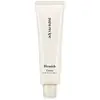What's inside
What's inside
 Key Ingredients
Key Ingredients

 Benefits
Benefits

 Concerns
Concerns

 Ingredients Side-by-side
Ingredients Side-by-side

Galactomyces Ferment Filtrate
HumectantDipropylene Glycol
HumectantCaprylic/Capric Triglyceride
MaskingGlycerin
HumectantPanthenol
Skin ConditioningHydrogenated Polydecene
EmollientHydrogenated Polyisobutene
Emollient1,2-Hexanediol
Skin ConditioningButylene Glycol
HumectantNiacinamide
SmoothingCyclopentasiloxane
EmollientCyclohexasiloxane
EmollientC12-16 Alcohols
EmollientDimethicone
EmollientHydrogenated Lecithin
EmulsifyingDimethicone/Vinyl Dimethicone Crosspolymer
Skin ConditioningPalmitic Acid
EmollientAcrylates/C10-30 Alkyl Acrylate Crosspolymer
Emulsion StabilisingWater
Skin ConditioningTromethamine
BufferingGlyceryl Stearate
EmollientCetearyl Olivate
C14-22 Alcohols
Emulsion StabilisingStearic Acid
CleansingSorbitan Olivate
EmulsifyingDimethiconol
EmollientC12-20 Alkyl Glucoside
EmulsifyingAdenosine
Skin ConditioningC12-14 Sec-Pareth-7
EmulsifyingDisodium EDTA
Myristic Acid
CleansingEthylhexylglycerin
Skin ConditioningXanthan Gum
EmulsifyingGlucose
HumectantCamellia Japonica Seed Oil
EmollientCeramide NP
Skin ConditioningPropylene Glycol
HumectantSaccharomyces/Xylinum/Black Tea Ferment
Skin ConditioningLinoleic Acid
CleansingLactobacillus/Soybean Ferment Extract
Skin ConditioningLactobacillus/Acerola Cherry Ferment
Skin ProtectingLactobacillus/Punica Granatum Fruit Ferment Extract
Skin ConditioningLactobacillus/Wasabia Japonica Root Ferment Extract
AntioxidantLactobacillus/Hibiscus Sabdariffa Flower Ferment Filtrate
Skin ConditioningSh-Oligopeptide-1
Skin ConditioningGalactomyces Ferment Filtrate, Dipropylene Glycol, Caprylic/Capric Triglyceride, Glycerin, Panthenol, Hydrogenated Polydecene, Hydrogenated Polyisobutene, 1,2-Hexanediol, Butylene Glycol, Niacinamide, Cyclopentasiloxane, Cyclohexasiloxane, C12-16 Alcohols, Dimethicone, Hydrogenated Lecithin, Dimethicone/Vinyl Dimethicone Crosspolymer, Palmitic Acid, Acrylates/C10-30 Alkyl Acrylate Crosspolymer, Water, Tromethamine, Glyceryl Stearate, Cetearyl Olivate, C14-22 Alcohols, Stearic Acid, Sorbitan Olivate, Dimethiconol, C12-20 Alkyl Glucoside, Adenosine, C12-14 Sec-Pareth-7, Disodium EDTA, Myristic Acid, Ethylhexylglycerin, Xanthan Gum, Glucose, Camellia Japonica Seed Oil, Ceramide NP, Propylene Glycol, Saccharomyces/Xylinum/Black Tea Ferment, Linoleic Acid, Lactobacillus/Soybean Ferment Extract, Lactobacillus/Acerola Cherry Ferment, Lactobacillus/Punica Granatum Fruit Ferment Extract, Lactobacillus/Wasabia Japonica Root Ferment Extract, Lactobacillus/Hibiscus Sabdariffa Flower Ferment Filtrate, Sh-Oligopeptide-1
 Reviews
Reviews

Alternatives
Ingredients Explained
These ingredients are found in both products.
Ingredients higher up in an ingredient list are typically present in a larger amount.
Propylene Glycol is an odorless, colorless liquid. As a humectant, it helps skin retain moisture. It also aids in delivering active ingredients.
Another role of this ingredient is preventing a product from melting or freezing. Propylene glycol also adds antimicrobrial properties to a product, elongating product lifespan.
This ingredient is considered an organic alcohol and commonly added into both cosmetics and foods.
Those with sensitive skin or conditions may develop a rash when using this ingredient.
Learn more about Propylene GlycolStearic Acid is a fatty acid. It is an emollient, emulsifier, and texture enhancer.
As an emollient, stearic acid helps soften skin. It aids the skin's protective barrier by preventing water loss. It also provides a gentle cleansing effect without stripping away natural oils.
Stearic acid may also be used to enhance the texture of products. It can add volume and stabilize ingredients such as water and oil. This can help water and oil ingredients from separating.
Sources of stearic acid include animal or vegetable fats/oils such as coconut or shea. It can be naturally found in butter, cocoa butter, shea butter, vegetable fats, and animal tallow.
This ingredient may not be Malassezia folliculitis, or fungal-acne safe.
Learn more about Stearic AcidWater. It's the most common cosmetic ingredient of all. You'll usually see it at the top of ingredient lists, meaning that it makes up the largest part of the product.
So why is it so popular? Water most often acts as a solvent - this means that it helps dissolve other ingredients into the formulation.
You'll also recognize water as that liquid we all need to stay alive. If you see this, drink a glass of water. Stay hydrated!
Learn more about WaterXanthan gum is used as a stabilizer and thickener within cosmetic products. It helps give products a sticky, thick feeling - preventing them from being too runny.
On the technical side of things, xanthan gum is a polysaccharide - a combination consisting of multiple sugar molecules bonded together.
Xanthan gum is a pretty common and great ingredient. It is a natural, non-toxic, non-irritating ingredient that is also commonly used in food products.
Learn more about Xanthan Gum